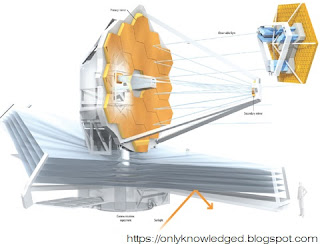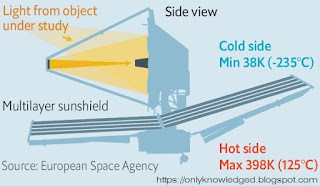James Webb Space Telescope "The Miracle of Science" | Part 5
The film has also been carefully moulded with corrugations and other shapes to stiffen and shape the shield as needed.
This passive cooling system helps tremendously, ensuring the dark side of the telescope is shielded from the sun's heat keeping it’s sensitive heat detecting instruments at 40 degree Kelvin, about -233 degrees Celsius. But parts of the telescope, specifically the mid-infrared detection instrument, located here, needs to be even colder to work correctly.
It needs to be 7 degrees Kelvin, just 7 degrees off the absolute minimum temperature of the universe of zero degrees Kelvin, and for this we need active cooling.
The James Webb telescope includes an innovative cryocooler for this purpose. The challenge in developing this cryocooler alone was immense, costing 150 million dollars. Getting cold temperatures is just one small part of the design.
Vibration has to be eliminated, as the tiniest movement at the telescope would cause massive blurs in the image as it attempts to focus on objects billions of light-years away. That means eliminating moving parts where possible, and when that can’t be done incredibly precise machining and movement is needed to balance weights as they move.
The cooler also needs to use a tiny amount of electricity, as the telescope only has 2000 watts of power provided by it’s solar array, and it needs to run reliably for years. That means a closed loop cycle, with our refrigerant being continually reused.
The pre-cooler features a two-cylinder horizontally-opposed pump and cools helium gas using pulse tubes, which exchange heat with a re-generator acoustically.
Horizontally opposed pumps, with carefully balanced pistons that will cut vibrations as the weights balance each other out, but the rest of that explanation sounds like it came straight out of a sci-fi novel.
A sound wave is just a pressure wave and pressure & temperature are directly proportional. Higher pressure will cause higher temperature.
One way we can take advantage of this is by creating a standing wave, where the peaks and troughs of the wave are stationary.
We can do this in a closed tube where the resonant frequency of the tube is determined by the tube's length. Here the sound wave will bounce off the closed end and create a region of compression and high pressure, and therefore high temperature.
The energy and temperature in this system will stay relatively stable, left on its own, but what if we could extract some of this heat with each cycle? Then, on each cycle, we could gradually cool the overall system.
To do this, we need a way to pass energy out of the system, This is done with a stack, a porous material with air gaps that allow sound to pass through it, which is placed so that it smoothly spans both the hot region at the end of the tube and the cold region in the center. A heat exchanger is then placed on either end of the stack, one for the hot side and one for the cold.
The hot heat exchange will conduct its heat to the centre of the sunshield, where it can radiate out to space, while the cold portion will conduct its heat, or lack thereof, to a copper plate attached to the back of the infrared sensors to cool them to 6.2 degrees kelvin.
This is an extreme over simplification of the actual operation of the pulse tube cryocooler. This is just a basic explanation of the physical phenomenon that allows it to work.
Click here to Continue reading... [Part 6] Coming soon








0 Comments
Hope Everyone Reading my posts are gaining KNOWLEDGE and able to know something new and informative.
📚📖📕🧾📝😅
Sharing is Caring. So please share this website with everyone you know so that they can also improve their KNOWLEDGE !!!